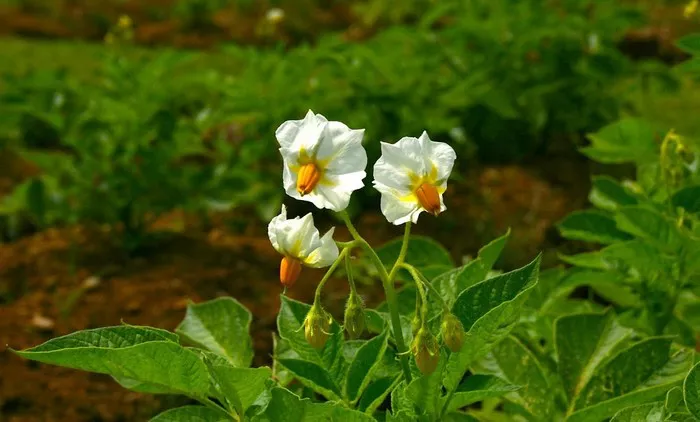Potatoes are a staple in many diets worldwide, loved for their versatility and nutritional value. While traditional potato farming involves vast fields, advancements in gardening techniques have made it possible to grow potatoes in smaller spaces, such as flower pots. Planting potatoes in flower pots is not only practical for those with limited outdoor space but also offers the convenience of easily accessible, homegrown produce. However, it requires careful consideration of various factors to ensure successful growth and a bountiful harvest.
Factors Affecting Potatoes in Flower Pots
Before diving into the planting process, it’s essential to understand the factors that can influence the growth of potatoes in flower pots:
1. Pot Size and Type: The size and material of the flower pot significantly impact the growth of potatoes. Opt for large pots with a minimum depth of 12 inches to allow ample space for tuber development. Additionally, choose pots made of breathable materials such as ceramic or fabric to promote proper aeration and drainage.
2. Soil Quality: Potatoes thrive in well-draining, loose soil with a pH level between 5.0 and 6.0. Use a high-quality potting mix enriched with organic matter, such as compost or aged manure, to provide essential nutrients for healthy growth.
3. Sunlight Exposure: Potatoes require at least six to eight hours of sunlight daily to photosynthesize effectively. Choose a sunny location for your flower pots, such as a south-facing patio or balcony, to ensure adequate sunlight exposure.
4. Temperature and Climate: Potatoes prefer cool temperatures between 60°F and 70°F (15°C to 21°C) for optimal growth. Protect your flower pots from extreme heat or cold, as temperature fluctuations can affect tuber formation and overall plant health.
5. Watering Routine: Proper watering is crucial for potato plants, especially during the growing season. Keep the soil consistently moist but not waterlogged to prevent rotting. Avoid overhead watering to minimize the risk of foliage diseases.
A Detailed Guide to Planting Potatoes in Flower Pots
Now that we’ve explored the key factors let’s delve into the step-by-step process of planting potatoes in flower pots:
1. Selecting Seed Potatoes: Choose certified disease-free seed potatoes from a reputable supplier. Cut larger seed potatoes into pieces, ensuring each piece contains at least two eyes or sprouts. Allow the cut pieces to air dry for a day to prevent rotting.
2. Preparing the Flower Pot: Fill the bottom of the flower pot with a few inches of well-draining potting mix. Place the seed potatoes evenly spaced on top of the soil, with the sprouts facing upward.
3. Layering Soil: Add another layer of potting mix, covering the seed potatoes completely. Leave a few inches of space between the soil surface and the rim of the pot to accommodate watering.
4. Watering and Mulching: Water the soil thoroughly until it’s evenly moist but not waterlogged. Apply a layer of mulch, such as straw or shredded leaves, to help retain moisture and suppress weed growth.
5. Placement and Sunlight: Position the flower pot in a sunny location with ample sunlight exposure. Rotate the pot regularly to ensure uniform growth and prevent the plants from leaning towards the light source.
6. Watering Routine: Check the soil moisture regularly and water as needed to keep it consistently moist. Avoid overwatering, as excessive moisture can lead to fungal diseases and root rot.
7. Fertilization: Once the potato plants start growing, apply a balanced fertilizer high in potassium every 2-3 weeks to promote tuber development. Follow the manufacturer’s instructions for proper application rates.
8. Hilling Up: As the potato plants grow taller, gradually add more soil to the pot, covering the lower stems and leaving only the top few inches of foliage exposed. This process, known as hilling up, encourages the formation of additional tubers along the buried stems.
9. Monitoring and Pest Control: Keep an eye out for signs of pests and diseases, such as potato beetles or fungal infections. Remove any affected foliage promptly and consider using organic pest control methods if necessary.
10. Harvesting: Potatoes are ready for harvest when the foliage starts to yellow and die back. Carefully dig around the base of the plants to avoid damaging the tubers, then gently lift them out of the soil. Allow the harvested potatoes to cure in a cool, dark place for a week before storing them in a cool, dry location.
Tips for Planting Potatoes in Flower Pots
To maximize your success with planting potatoes in flower pots, consider the following tips:
1. Choose the Right Varieties: Select potato varieties suited for container gardening, such as fingerlings or small salad potatoes, to ensure optimal growth in limited space.
2. Space Management: Plant potatoes in a staggered manner within the flower pot to maximize space utilization and increase yields.
3. Regular Maintenance: Stay vigilant with watering, fertilizing, and pest control to ensure healthy potato plants and a successful harvest.
4. Crop Rotation: Avoid planting potatoes in the same flower pot or location year after year to prevent the buildup of soil-borne diseases and pests.
5. Experiment with Different Containers: Get creative with container choices, such as grow bags or recycled containers, to find what works best for your space and aesthetic preferences.
6. Companion Planting: Consider companion planting with herbs or flowers that repel pests or attract beneficial insects to create a harmonious garden ecosystem.
7. Successive Planting: Extend your potato harvest by planting successive crops at different times throughout the growing season.
Conclusion
By following these guidelines and tips, you can enjoy a bountiful harvest of homegrown potatoes right from your flower pots. With a little patience and care, you’ll soon be savoring the delicious rewards of your gardening efforts.


